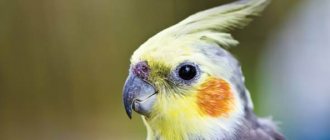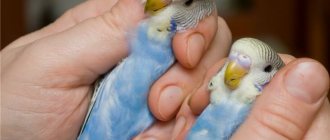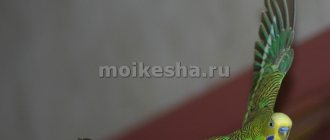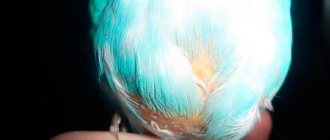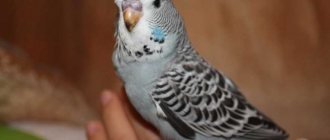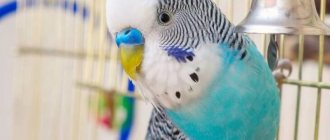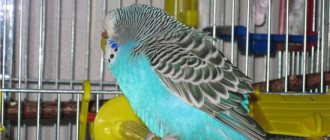The metabolism of birds is accelerated several times compared to humans. Therefore, only a few days may pass from the first symptoms of the disease to a serious condition and even death of the pet. However, as in mammals, the appearance of excrement has important diagnostic significance. It is important to understand what kind of droppings a parrot should have and take timely measures if the texture and color changes.
What type of litter should a parrot have?
Birds have a single excretory system: they simultaneously defecate and excrete urine. Therefore, the normal state of excrement is: semi-liquid, interspersed with solid, but not excessively “stony” substance. The color of parrot droppings is brownish, sometimes with a greenish tint. Like other animals, the condition of excrement largely depends on nutrition; if a bird eats a lot of fruits and grains, then the shade of the excrement will be closer to greenish and somewhat softer, and if the diet includes more vegetables and cereals, then the feces will be darker and denser.
Birds eat a lot relative to their own weight; they have increased energy needs, which are spent primarily on flight. Accordingly, defecating up to forty to fifty times a day is the norm for small species of parrot. Large ones empty themselves twenty to thirty times a day.
The process should not cause discomfort to the pet or stain the feathers under the tail, so if the parrot’s droppings stick to the butt, this is a sign of digestive dysfunction. Frequent or infrequent bowel movements also indicate pathologies of the bird’s gastrointestinal tract.
We sort bird droppings by shade
If you notice diarrhea, examine it carefully - this will help you eradicate the cause of its occurrence and speed up the bird’s recovery. If there is bloody discharge in loose stools, then immediately rush to a specialist, he will know what to do next. The liquid stool of a budgerigar is conventionally divided into white, green and black droppings.
White droppings
White, beige or grayish color of droppings, as in the photo, is found in birds that have too fatty foods in their diet. If white feces are detected, you must immediately stop giving nuts and seeds. Follow a strict diet and, if possible, abstain from milk.
When the stool is of normal color, as if heavily diluted with white or transparent inclusions, consult a doctor immediately. This type of litter occurs with arthritis and stress. Complex treatment of the body is necessary:
- balance nutrition;
- improve psychological state;
- take a vitamin complex.
Green droppings
Coloring green, as well as yellow, yellow-green, is a clear sign of poisoning, as in the photo. Green loose stools can be the cause of poisoning from both food and parasites. First aid for green droppings is to feed with dietary porridge. Go to the veterinarian, you won’t be able to cope without his help, especially if the stool does not form at all or is very liquid.
Black droppings
One of the most dangerous is black droppings, which signal internal bleeding. Sometimes black stool occurs due to the presence of parasites, although they can be seen with the naked eye in such stool. It is advisable to go to the doctor for medicine.
Why does a parrot have a certain color of droppings?
The color of excrement is an important criterion that helps to understand that the parrot has health problems, and at the same time suggest a disease or condition of the body. The veterinarian will always ask about how the bird “goes to the toilet,” but the owner, even without special education, can try to make assumptions based on what the pet’s droppings look like.
Green
Green droppings on a parrot should be an alarming symptom for the owner. What is meant is not a greenish tint between brown and brown, but an intensely saturated color, especially if the consistency is broken and the excrement looks liquid. This state of stool indicates the following pathologies:
- Liver diseases - both chronic and acute, for example, pathology caused by poisoning.
- If there are no pronounced dense inclusions - urates, then this indicates that the bird has not eaten anything, only urine is excreted.
- All together this is a serious symptom that requires immediate medical attention and means that the bird cannot eat normally or the liver cannot cope with digestion.
Parrots cannot go hungry. Just a day without food means destruction of the gastrointestinal tract, even death. The most dangerous sign: the absence of urates against the background of green discharge, so if the parrot has green droppings, the first thing to do is take the pet to the doctor.
White
White droppings in a parrot sometimes appear as a reaction to stress: nervous birds drink a lot, the amount of liquid increases, and the solid part becomes less concentrated. Thus, it is more frequent urination than defecation. If the amount of liquid surrounding urate has not changed, then light grayish or whitish droppings indicate problems with the enzyme system. As a rule, this symptom occurs when the functions of the pancreas are impaired. Another disease that causes this change in excrement is arthritis, caused by too much calcium in the diet.
Yellow
The most common cause of yellow droppings in parrots is liver disease and gallbladder dysfunction. As with intense green tints, it's a good idea to see a doctor as soon as possible. Sometimes this shade appears as a result of the activity of endoparasites (worms), which actively destroy internal organs.
Black
The appearance of black droppings in a parrot is evidence of bleeding in the upper intestines. It can be caused by injury, but more often the symptom appears as a result of the activity of parasites. The condition is always dangerous, especially for small parrots such as budgies or lovebirds.
Brown
An unsaturated brownish-brown tint is considered normal in the absence of other signs. If the color changes towards darker, then it is worth suspecting disturbances in the vital functions of the bird’s body. The brown color of a parrot's droppings is a characteristic sign of helminthic infestation or a bacterial infection in the intestines. Associated symptoms: loss of appetite, poor health. The bird becomes less playful and eats poorly.
Liquid
Just like in humans, diarrhea in feathered pets can occur for many reasons. The most common types of liquid droppings in parrots are associated with the following problems:
- stress - it is considered normal if the stool softens in the first two to three days after moving to a new home;
- reaction to poor quality food, indigestion;
- infectious diseases - green droppings with water in a parrot - this is an early sign of a pathological process with external well-being, other symptoms appear later.
It is important not to confuse diarrhea with polyuria, and also to ensure that your pet is not dehydrated. Normally, females urinate more often before laying eggs, or simply birds who love juicy fruits. Urates retain their color and shape, and the discharge has almost no odor. Other situations suggest pathology.
With blood
Bright scarlet blood indicates injury to the cloaca or lower intestine. However, simply dark feces are always suspicious of the presence of hidden blood. A dark brown or black tint is suspicious from this point of view. You can determine whether a parrot has blood in its droppings by dropping hydrogen peroxide on the secretion: hissing will indicate the presence of an undesirable impurity. The cause of injury is the activity of parasites, some types of infections, mechanical damage, poisoning with toxic substances, tumors. In females, blood in the stool often means damage from egg laying.
Consequences and complications of diarrhea
Frequent bowel movements weaken the muscles that hold the cloaca in place.
There are times when part of the cloaca falls out, dries out and causes great discomfort to the bird. The parrot scratches the irritated, itchy areas of the prolapsed organ with its claws and pecks at it, trying to relieve the pain. Such discomfort does not give the bird peace; it constantly suffers, wasting its last strength. Prolonged diarrhea is a threat not only to the health, but also to the life of a budgie. If diarrhea does not stop for more than a day, the following complications are possible:
- the body becomes dehydrated;
- oppression of vital systems begins;
- internal organs cannot cope with intoxication;
- the blood thickens, its circulation becomes difficult;
- food is not digested, immediately passing from the esophagus into the intestines.
Without timely assistance, the parrot quickly loses weight and may die.
A budgerigar is a small bird, but it does not get sick any more easily than a large one. On the contrary, a fragile body is more susceptible to complications. often develop rapidly, the bird can fade away in a matter of days. If you are unable to help your pet, do not hesitate - contact your veterinarian.
Why are there undigested grains in the droppings?
Undigested grains in a parrot's droppings can occur for a variety of reasons, from harmless to serious. The simplest option: overeating, food is excreted unchanged because the body did not have time to cope with the food. However, this sign is also undesirable, because excess food overloads the bird’s gastrointestinal tract and is dangerous by clogging the crop. Other reasons include:
- dysbacteriosis;
- lack of pancreatic enzymes;
- poor liver function.
An enlarged neck indicates inflammation and blockage of the goiter. This is a serious disease that requires surgery. The veterinary drug Vetom 1.1 helps well against dysbacteriosis.
Cloacite
Cloacitis, or inflammation of the cloaca, is caused by bacteria that irritate the lining of the area. The reason may be non-compliance with the diet, poor quality feed mixture, prohibited foods, lack of vitamins, non-compliance with housing conditions (lack of disinfection).
Associated symptoms are:
- loose stools;
- swelling and redness of the skin;
- feathers stick together in this area;
- appetite decreases;
- there is general malaise;
- there is mucus and blood discharge.
When a parrot has cloacitis, droppings stick to its butt. Feathers tend to stick together as a result of mucus secretions. Thus, the feces stain the feathers to a lesser extent and stick more directly to the butt itself.
It is very difficult to cure such a disease at home. You need to seek help from an ornithologist. You can alleviate your pet's condition with marshmallow decoction. Iron sulfate, burnt magnesia, and glycerin are used. The doctor may prescribe a course of antibiotics.
Douching is used to treat cloacitis. 1 bottle of Penicillin is diluted in a glass of water. Can be stored in the refrigerator for a long time. For the procedure, a regular syringe without a needle is used. Draw 1 ml of cool solution and syringe the cloaca twice a day. Then synthomycin emulsion 0.3 ml is administered. To maintain general immunity, Gamavit vitamins are included in the diet.
Why does droppings stick to a parrot's butt?
If the droppings remain under the parrot's tail, we are talking about a dense consistency of excrement, indicating digestive disorders and dehydration of the bird. Diseases associated with the condition:
- goiter inflammation;
- infectious diseases that provoke dehydration;
- constipation is a rare phenomenon in birds and is associated with poor food.
Some professional breeders recommend washing the feathers under the tail yourself, giving an enema and pouring liquid into the beak. But the best solution would still be to go to the veterinarian if there is any suspicious change in the parrot’s excrement.
Causes of pathology
There are several reasons for pathological changes in the body of birds:
Diseases of the digestive system provoke the appearance of polyuria. The predominance of soft food in the pet’s diet: juicy fruits, grass, vegetables. Stress is the most common cause of illness. It provokes the production of the hormone cortisol, which causes the development of polyuria. After a parrot gets into a stressful situation, you can observe it releasing fluid with droppings. If the stool does not improve after a few days, you need to seek help from a veterinary hospital. During the egg-laying period, polyuria may occur in a female parrot. Most medications cause dehydration. Hormones and antibiotics lead to stool thinning
They should be used with caution and should not be used if the pet is dehydrated. A lack of vitamin A in the diet of birds can cause illness. Atrophy of the mucous membrane of the esophagus and digestive organs leads to impaired absorption of fluid. Excess vitamin D in commercial feed. Excess calcium in poultry diet. All types of parasites, including worms, can cause the development of the disease. These organisms negatively affect the functioning of internal organs, which leads to malfunctions and impaired absorption of nutrients from food. An excess of protein products in the diet of birds leads to malfunctions of the digestive system and adrenal glands.
If symptoms of polyuria appear, it is necessary to review your pet’s diet and limit water consumption. If the deviations are systematic, you need to get tested and identify the cause of the uncontrolled release of fluid.
Symptoms of constipation
It is not easy to notice that a parrot is constipated. This can only be done by a very attentive owner. First of all, changes that are associated with the color and quality of the litter should catch your eye. If there are problems with the intestines, it becomes denser and acquires a gray or light yellow color. Also, with this disorder, the bird may lose its appetite.
If constipation has been going on for quite a long time, then, taking a closer look at the bird, you will see a lot of changes. The main ones include:
- Depressed mood of the bird.
- No droppings in the cage.
- Very long intervals between bowel movements.
- Frequent attempts by the parrot to pluck a place in the cloaca area.
- The pitiful squeak of a bird.
- Presence of bloating.
If you have already noticed such changes with your pet, then it is necessary to begin treating it as quickly as possible. After all, we can no longer talk about days, but even about hours, and if you do not have time to help the bird, it will die.
Especially dangerous is litter that has acquired an orange or red color. This color indicates the presence of a bacterial infection, poisoning, and damage to the gastrointestinal tract.
Difficulty with bowel movements
Constipation in budgies is much less common than diarrhea. Constipation usually occurs due to feeding the bird poor quality food. Typically, this is food that has either expired or is of poor quality. Often these are some stale grains and foods that contain a lot of fat.
During constipation, the bird is in a depressed state. In most cases, she makes a plaintive squeak and beats her tail. A constipated pet's droppings are too dense a substance and are larger in volume than they were before the disease.
Treatment for constipation in a budgie begins with throwing out the previous food and buying new food. It should contain more than 2-4 percent flax seed.
After this, Vaseline or castor oil is dripped into the bird’s beak. To make this procedure more convenient, it is recommended to use a pipette. As for the number of drops, it is usually prescribed to instill 3-4 drops per day. It is advised to take a pipette or syringe (without a needle) and inject a little Vaseline or castor oil into the parrot's cloaca.
If all else fails, consult a veterinarian. In general, if possible, contact a specialist immediately. Sometimes only an examination by a qualified doctor and test results can suggest an accurate diagnosis, based on which the correct treatment will be prescribed.
Patient care
During treatment, drafts and hypothermia are avoided. For additional heating, turn on the ultraviolet lamp for two hours. Silence is required. Fruits, greens and seeds are removed from the diet. The diet includes porridge, bone meal, sulfur and crushed shells. Additionally, mineral stone and shell rock are placed. If there is no appetite, they are force-fed. Obligatory watering.
The pet in the cloaca area is washed with warm water, and the feathers are cleaned of adhering dirt. The cage is disinfected.
If the measures taken do not improve the pet’s condition, you should immediately contact a veterinarian. Delay threatens death.
